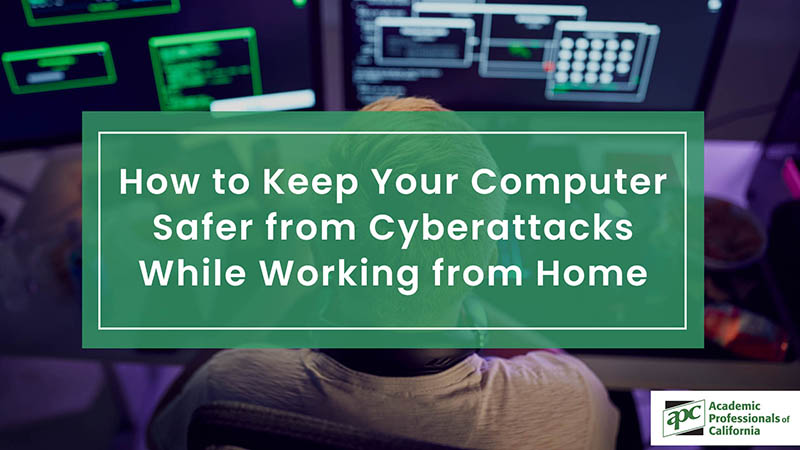If you work from home, your computer is an essential mode of communication with your office. You may be sending emails back and forth, transferring data, co-working on a shared screen live, or videoconferencing. In all cases, your computer must connect to the internet, and when it does, it’s vulnerable to cyberattacks.
Cyberattacks don’t just affect your computer access, personal data, finances, or identity. When you work from home, they also pose the same risks to your employer.
Cybercrimes cost businesses approximately $1.5 billion per year, and this number is bound to increase as the shift to working from home continues. A company requires a network of business VPNs, or Virtual Private Networks, and secure home internet connections for employees to work from home. This lends itself to hacker activity.
Fortunately, there are several simple yet effective steps you can take to protect yourself and your campus from cyberattacks.
Use Antivirus and Malware Protection Software
Install and run a comprehensive internet security program on all your computers connected to the internet. Make sure it includes antivirus protection as well as protection from all other prevailing forms of malware, including:
- Spyware
- Keyloggers
- Ransomware
- DDoS attacks
- Trojans and worms
- Phishing scams
Avoid Unrecognized Sources
If you receive an email from an unfamiliar source, don’t click on any attachment or link included with that message. Hackers often use links and attachments to trigger malware to download and install on any systems that open them.
If you’re ever unsure about the source of a particular email, message request, or other correspondence, always check with the supposed source for confirmation before interacting with it. Use the contact information you have on file for the person. Don’t simply reply to the message.
Keep Devices for Work and Personal Use Separate
Use your work computer and other work-related internet-enabled devices, including laptops, tablets, smartphones, printers, and scanners, exclusively for work. If you or your family members use a computer or other internet-enabled device for school or personal use, make sure those devices are not the same ones you use for work.
Turn Off Work Devices When Not in Use
When you’re finished using your work devices, shut them down completely, Then turn them back on when you’re ready to resume work. Don’t just put them to sleep or close your laptop lid. Get a cover for your webcam too and cover it whenever it’s not in use.
Hackers can access “sleeping” devices and laptops that are powered on but have their lids closed.
Password Protection
Use password protection for all the electronic devices you use for work, including your internet router and WiFi. Requiring a user to enter a password before a device opens makes it much harder for a cyberattacker to access that device.
Use complex passwords that contain capital and lowercase letters as well as symbols and numbers. Don’t create a password containing any information related to your life or past, such as a birthday or former address, to help you remember it. These are much easier for a hacker to figure out.
Instead, use a password manager to generate random, complex, unique passwords difficult for cybercriminals to hack. Set up a different password for each device and each account you need to access at any point, such as your work email or a Zoom account.
There are free and paid for tools for storing passwords, You can use Google password manager or any number of other options.
A secure password manager automatically enters a password once you’ve proven your identity. You don’t need to write down your passwords anywhere or try to remember, and subsequently forget, them.
Use Advanced Security Protocols
Improving your use of passwords and password tools to make your devices, accounts, and files more secure is a significant step toward preventing unwanted access to those items. It’s not the only step, however.
You can, and should, also implement modern advanced cybersecurity tools like multifactor authentication, fingerprint logins, and facial recognition tools.
Set up a virtual private network (VPN) for your internet connection that only you and your employer can use instead of using a shared network that others use as well. In addition to being the only one using your internet connection, you also gain the additional advantages of whatever security protocols your internet host uses to protect your VPN.
The more security walls you can put in place to ward off cyberattackers, the better.
In many cases, these layers of security protocols don’t need to be perfectly impenetrable. Simply having so many obstacles in place for a cybercriminal to overcome to gain access can deter many an attacker from even attempting.
Many hackers may pass you over and seek out a new potential victim whose digital assets have much fewer hurdles to leap and, in that alone, are easier to hack.
In Summary
By employing these time-tested methods of protecting your computers from cyberattacks, you have a better chance of being protected when you are online and offline.
You may want to check with your campus IT department for recommendations as well.


